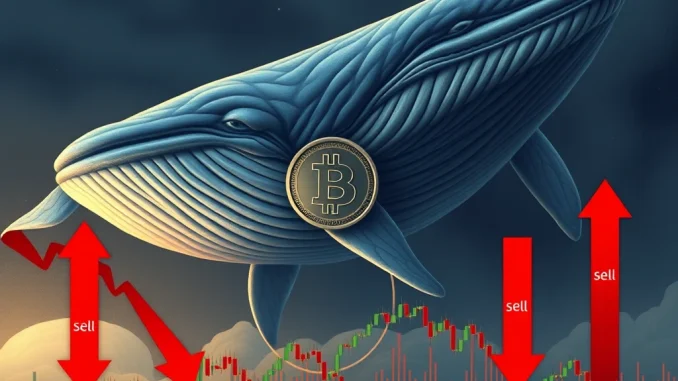
Just when the crypto market was riding a wave of optimism since April 9th, a significant development has sent ripples through the Bitcoin ecosystem. According to prominent crypto analyst Ali Martinez, Bitcoin whales have executed a massive sell-off, offloading over 29,000 BTC in the past seven days. This news arrives amidst an ongoing rally, raising eyebrows and sparking crucial questions: What does this mean for the current market momentum? Is this a sign of a potential downturn, or just a temporary correction? Let’s dive deep into the implications of this Bitcoin whale activity and what it could mean for you.
Decoding the Actions of Bitcoin Whales
Who exactly are these Bitcoin whales, and why does their activity matter so much? In the cryptocurrency world, ‘whales’ refer to individuals or entities holding substantial amounts of a particular cryptocurrency, in this case, Bitcoin. Their large holdings mean that their trading actions can have a significant impact on market prices. Think of it like this: if a regular trader sells a small amount of Bitcoin, it might not even cause a ripple. But when a whale decides to sell thousands of BTC, it’s like a tidal wave hitting the market.
Here’s why tracking Bitcoin whale movements is crucial:
- Market Movers: Whales possess the capital to influence market trends. Their buy or sell orders can create significant price swings.
- Early Indicators: Whale behavior can sometimes foreshadow broader market shifts. Large sell-offs might indicate a lack of confidence in the current price levels or anticipation of negative market events.
- Sentiment Gauge: Observing whale accumulation or distribution patterns can offer insights into the overall market sentiment among major players.
However, it’s important to remember that whale activity is not always a predictor of doom and gloom. Sometimes, whales might sell for profit-taking after a rally, portfolio rebalancing, or even to cover operational costs. The key is to analyze these movements in context and avoid knee-jerk reactions.
The Anatomy of the Recent BTC Sell-Off
The recent BTC sell-off, as reported by Ali Martinez on X, involves a staggering 29,000 Bitcoin moved by whale entities within just seven days. To put this into perspective, at a Bitcoin price of around $60,000, this equates to over $1.7 billion worth of Bitcoin being sold! This substantial volume naturally raises concerns about its potential impact on the market’s upward trajectory.
Let’s break down the key aspects of this BTC sell-off:
| Metric | Value |
|---|---|
| Bitcoin Sold | Over 29,000 BTC |
| Time Period | Past Seven Days |
| Source of Information | Crypto Analyst Ali Martinez (via X) |
| Context | Ongoing Market Rally since April 9th |
While the exact reasons behind this BTC sell-off remain speculative, several factors could be at play:
- Profit Taking: After the recent rally, whales might be taking profits, especially if they bought Bitcoin at lower prices.
- Market Correction Anticipation: Some whales might believe the market is due for a correction and are selling to avoid potential losses.
- Portfolio Diversification: Whales might be reallocating funds to other cryptocurrencies or traditional assets.
- Macroeconomic Factors: Global economic uncertainties or regulatory concerns could be influencing whale decisions.
Ripple Effects on the Crypto Market
The crypto market is an interconnected ecosystem, and significant movements in Bitcoin often have a cascading effect on other cryptocurrencies. A large BTC sell-off by whales can inject fear and uncertainty into the broader market, potentially leading to:
- Price Corrections: Increased selling pressure on Bitcoin can trigger price drops, which may extend to altcoins as well.
- Increased Volatility: Whale activity can amplify market volatility, making it more challenging for traders, especially those using high leverage.
- Sentiment Shift: Negative news like whale sell-offs can quickly shift market sentiment from bullish to bearish, impacting investor confidence.
- Trading Opportunities: For astute traders, volatility can also present opportunities to buy the dip or profit from short-term price fluctuations.
However, it’s crucial to remember that the crypto market is also resilient and adaptable. Short-term sell-offs, even by whales, don’t necessarily dictate long-term trends. The underlying fundamentals of Bitcoin and the broader crypto space, such as adoption, technological advancements, and institutional interest, remain strong.
Analyzing Historical Whale Activity for Insights
To better understand the current situation, let’s consider historical whale activity patterns. Examining past instances of significant whale sell-offs can provide valuable context and help us gauge potential market reactions.
Historically, periods of intense whale activity have often coincided with:
- Market Peaks: Whales sometimes sell near market tops to maximize profits before potential downturns.
- Bear Market Entrances: Large-scale whale selling can exacerbate downward pressure and contribute to the onset of bear markets.
- Major News Events: Significant regulatory announcements, macroeconomic shifts, or black swan events can trigger whale reactions.
- Accumulation Phases: Conversely, periods of whale accumulation have often preceded bull runs, indicating growing confidence and anticipation of price increases.
By studying historical charts and on-chain data, analysts can identify patterns and correlations between whale activity and market movements. Tools that track whale transactions and wallet balances are invaluable for gaining these insights. However, it’s crucial to avoid relying solely on historical data, as market dynamics are constantly evolving.
Bitcoin Price: What’s Next?
The million-dollar question is: what does this Bitcoin price action mean for the future? Will this whale sell-off trigger a significant price correction, or is it just a temporary speed bump on the road to higher prices?
Predicting the exact Bitcoin price trajectory is impossible, but we can consider a few potential scenarios:
- Short-Term Correction: The sell-off could indeed lead to a short-term price correction as selling pressure increases. However, strong buying interest at lower levels could limit the downside.
- Consolidation Phase: The market might enter a consolidation phase, where price movements are range-bound as the market digests the whale activity and seeks new direction.
- Continued Rally (with Volatility): Despite the sell-off, the underlying bullish momentum could persist, and the rally might resume, albeit with increased volatility.
- Bearish Turn (Less Likely, but Possible): If the whale sell-off is a precursor to broader negative sentiment or negative news, it could potentially signal a more significant bearish turn.
Actionable Insights for Crypto Enthusiasts:
- Stay Informed: Keep a close watch on market news, analyst reports, and on-chain data to stay ahead of potential market shifts.
- Manage Risk: Be cautious with leverage during periods of high volatility. Consider diversifying your portfolio and setting stop-loss orders to manage risk.
- Long-Term Perspective: Remember that crypto markets are cyclical. Short-term price fluctuations are normal. Focus on the long-term fundamentals and your investment strategy.
- DYOR (Do Your Own Research): Don’t make investment decisions based solely on headlines or whale activity. Conduct thorough research and understand the risks involved.
Conclusion: Navigating the Whale-Infested Waters
The recent Bitcoin whale sell-off serves as a stark reminder of the significant influence these large holders wield in the cryptocurrency market. While the news might seem alarming, it’s essential to approach it with a balanced perspective. Understanding whale activity, analyzing market context, and staying informed are crucial for navigating the often-turbulent waters of the crypto world. Whether this sell-off marks a temporary dip or a more significant shift remains to be seen. However, by staying vigilant, adaptable, and grounded in sound investment principles, you can better position yourself to weather any market conditions and capitalize on emerging opportunities in the ever-evolving crypto landscape.



